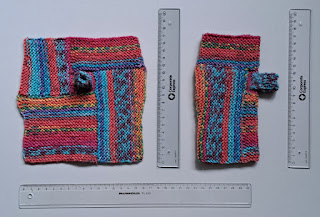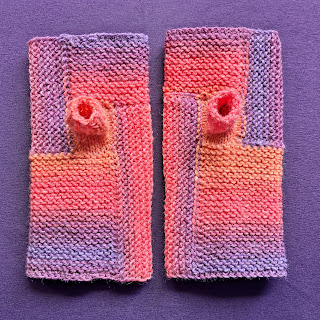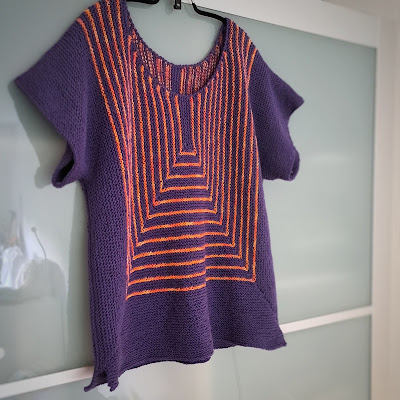One of my favorite TV programs is the Great British Sewing Bee. It's not only very "feel-good" program with lovely contestants, it's also quite inspirational and also provides background information about the history of clothing. So when I saw episode 4 of season 7 of the Great British Sewing Bee (the year before last) where the contestants had to sew a made to measure inspired by Frida Kahlo and especially the huipils that some of their designs were based on, I wanted to make something similar in knitting.
Even though the inspiration came (in a very roundabout manner) from Frida Kahlo and mexican Huipil garments, my finished top didn't look like it at all. And when somebody on Instagram said the top reminded them of Art Deco patterns, I loved it and it stuck as a name.
This is a boxy top with a round neckline, short sleeves and side slits at the bottom edge. It is started with a magic CO in the middle and knitted outwards to the side and bottom seams.
As with many of my sweater/top "patterns", this is NOT a row-by-row pattern for various sizes, but rather a rough recipe of the ideas behind the construction of this garment. I will give the numbers I used for myself as an example in purple.


This work by Knitting and so on is licensed under a Creative Commons Attribution-NonCommercial-ShareAlike 4.0 International License.
Materials
- yarn: I used a total of 300 grams of Sports weight yarn, the purple yarn was from my first attempt of my Garter Stitch Summer top - that eventually got frogged, the orange yarn was leftovers from my Eifel Cowl - I can imagine that it would also look nice to knit the whole top in one variegated yarn
- knitting needles: I used 3.5mm circulars, (three pairs of circular needles, in the when front or back piece got big enough - one for each of the three edges)
- a crochet hook of about the same size - for a crochet CO and for crocheting the neckline edge
- scrap yarn - as a stitch holder
- stitch markers
- a tapestry needle to weave in ends
Techniques & Definitions
- Judy's Magic Cast-On is a technique that gives you live stitches on both sides of your needle - it is generally used for toe-up socks, but it can be used for other purposes as well. Here's a written description (from Knitty) and here's a YouTube-video by Cat Bordhi and another YouTube-video by Very Pink Knits.
- Pick up and knit: Picking up stitches from the side edge of your work as shown in this YouTube video by B.Hooked Crochet & Knitting
- kfb: increasing by one stitch - by knitting into the front and back leg of a stitch; it is shown in this YouTube video by Knit Purl Hunter
- kbf: a stitch that is symmetrical to a kfb; e.g. shown in this YouTube-video by Roxanne Richardson: https://youtu.be/OJMya9xaol4 (it's perfectly possible to do a kfb instead, I just prefered the symmetrical look for my stripe pattern)
- Crochet CO: shown in this YouTube video by Knit Purl Hunter
- Reverse Single Crochet (Crab Stitch): a crochet stitch that makes for a lovely edging - shown in this YouTube video by Tamara Kelly - Moogly
- One garter stitch ridge equals two rows of garter stitch
Measuring, Calculating & Construction
The whole top has a boxy construction - based on a rectangles - that may not be the most flattering shape. If you want more shaping you could add short rows (maybe an underarm wedge) - however, this is not described here. Ideas to change the shape and dimensions of the piece can be found below in section "Other sizes".
 |
| Schematic - click on picture to enlarge |
The top is constructed as follows:
- each part (front & back) starts in the middle of the neckline with a magic CO;
- then you will knit in an angled U-shape around this CO, with increases at the corners that form a rectangular pattern), if you knit according to the instructions, you will add five ridges to the length for each four ridges to the width on each side, i.e. the piece grows downwards and sideways;
- meanwhile at the upper edge (neckline) you add increases to shape the rounded neckline - until you've reached the desired shoulder height; these neckline increases are different for front and back (the front neckline is deeper than the one in the back);
- once you've reached the desired width, you only work on the lower edge to add length, the stitches on the sides are put on stitch holders (scrap yarn)
- when you've finished front and back piece, you sew up the shoulder seams
- for the arms, you pick up the required number of stitches around the shoulder seams (one half from the side seam of the back piece, the other half from the front piece) and knit them in rows
- the sides are seamed up by holding rights sides together and doing a three needle BO
- finally, the underarm seams and shoulder seans need to be sewn up
The picture below shows the measurements that you need to take.
 |
| Measurements - click on picture to enlarge |
A = neck width
B = shoulder width
C = width of the piece (= A + 2xB)
Dfront = neck depth front
Dback = neck depth back
Efront = length of magic CO front
Eback = length of magic CO depth back
to get the same overall shape for front and back piece, the front neck depth plus the front CO must equal the back neck depth plus the back CO (Dfront + Efront = Dback + Eback)
F = length of main piece (front & back)
G = additional length
H = shoulder to underarm (or half of the arm circumference at the top)
I = arm length
Knitted in garter stitch my yarn/needles combination gave
- 10 cm in height for 22 ridges (44 rows) and
- 10 cm in width for 22 sts.
My desired measurements were
A = about 21 cm, i.e. 45 ridges (i.e. 1 ridge for the magic CO plus 22 on each side, 22x2 + 1)
B = about 14,5 cm, i.e. 29 ridges
C = 50 cm ( = 2x14,5 + 21)
Dfront = 12 cm, i.e. 25 sts
Dback = 4.5 cm, i.e. 11 sts
Efront = 7.5 cm, i.e. 18 sts
Eback = 15 cm, i.e. 33 sts
F = 49 cm
G = 4 cm
H = 21 cm , i.e. 46 sts
I = about 6.5 cm, i.e. 14 ridges
Even though you can adapt the size while knitting, I strongly suggest that you knit a swatch before starting, so that you have a rough idea of the number of stitches necessary (at least for the CO).
Because of the construction (and the rate the piece grows), I would advise to do choose the magic CO to a length that Dfront + Efront make up for about 40% of the overall length of the piece (that's the distance from the shoulder seams to the lower edge of the magic CO). This aims for C and F being roughly equal.
Another important issue: Make sure to take notes while you're knitting your pieces so that you can reconstruct it later, i.e. so that the back matches the front or the left sleeve matches the right.
Instructions
While you're knitting the main stripe pattern, you will at the same time have to increase along the neckline. Since - depending on your yarn weight and desired size - these issues need to be addressed separately, they are explained separately below.
Front - Main stripe pattern
You start knitting in the middle of the neckline. I wanted a rounded, wide(-ish) neck and about 12 cm deep. So I "started" the mCO in the knowledge that there would be 25 sts to increase to shape the neckline.
In MC do a magic CO so that there is one stitch more on the top than on the bottom needle (the additional stitch will make up the horizontal line of the pattern (see picture 1, the top needle has one more stitch than the bottom one).
I did a magic CO of 2x18+1 sts (i.e. after the neck increases are added the lower edge of the magic CO is 18 + 25 = 43 sts away from the shoulder seam)
Turn the needle so that you look at the garter stitch bumps (see picture 2), the needle with the additional stitch is still on top, however, the last stitch is not secured. Therefore, before you start knitting twist tail and working yarn once to secure the first stitch of the row (see picture 3).
In MC
Ridge 1: (RS) top needle, ktbl to last stitch on top needle, kfb, switch to bottom needle, k1, kbf, k to end
(WS): k to 2 bef end of needle, pm, k2, switch to other needle, k1, pm, k to end
In case of my magic CO this was:
Ridge 1: (RS) ktbl 17, kfb, k1, kbf, k17, turn
(WS) k18, pm, k3, pm, k18
Ridge 2: (RS) k all, turn
(WS) k to 1 bef m, kfb, sm, kbf, k to 1 bef m, kfb, sm, kbf, k to end
In CC
Ridge 3 (RS): k all, turn
(WS) k to 1 bef m, kfb, sm, kbf, k to 1 bef m, kfb, sm, kbf, k to end
in MC
Ridge 4: (RS) k all, turn
(WS) k to 1 bef m, kfb, sm, kbf, k to 1 bef m, kfb, sm, kbf, k to end
Ridge 5: (RS) k to 1 bef m, kfb, sm, kbf, k to 1 bef m, kfb, sm, kbf, k to end, turn
(WS) k to m, sm, k to m, turn; (RS) k to m, turn (WS) k to m, sm, pick up one stitch from edge, k to end
Pictures 4 to 6 illustrate how to pick up a stitch in the middle of a row. When knitting row 10 after you've turn for the second time and knitted up to the next marker you find a (short) edge (one ridge high) from which you have to pick up one stitch (see pointer in picture 4). You then insert the needle into that stitch (picture 5) and draw a loop of your working yarn through (picture 6).
The pictures also show that after a few ridges, I put the stitches between the markers (vertical part of the stripe pattern) on another needle. That way the piece is not distorted by being bunched up on two needles only. As the piece grew bigger I switched to 3 sets of circulars - one for each edge. (The "end of needle" did the job of the stitch marker.)
in CC
Ridge 6: (RS) k to m, sm, k to m, sm, pick up one stitch from edge, k to end, turn
(WS: k to 1 bef m, kfb, sm, kbf, k to 1 bef m, kfb, sm, kbf, k to end
Repeat ridges 4 to 6 until the colored panel is as big as you want it.
Then continue repeating ridges 4 to 6 in MC only.
(It theory, you could do the increases (kfb/kbf) always on RS. The reason I alternated is that it looked better with the stripe pattern, i.e. if you do a kfb in the first row after a color change, you see a little bump of the color below and I wanted to avoid that.)
I knitted 12 repeats, i.e. I knitted 12 CC stripes. Than I added 5 more repeats in MC only.
Front - neckline shaping
WHILE you're knitting the main stripe pattern, you need to increase at the beginning and end of some rows to shape the neckline. Since I wanted a rounded neckline, I started with few increases, raising their number towards the outer edge of the neckline.
I would advise that - once you calculated the width and height of your neckline - draft the desired shape on graph paper and do your increases accordingly.
The picture below shows the left half of the front neckline and how I distributed the increases - starting from the magic CO.
 |
| Neckline Shaping - click on picture to enlarge |
Increase in the beginning and end of one row means that I did a kfb at the second and the second to last stitch, i.e.:
k1, kfb (instructions for this row until 1 bef end), kfb, k1
At last ridge I did a crochet CO of 9 stitches at the beginning and the end of the row.
Finishing the front piece
If your piece isn't long enough, knit a few more ridges using the stitches of the lower edge.
I lenghtened both pieces by 6 ridges (12 rows) before binding off.
Put the stitches of the side edges on scrap yarn.
Your last row is a WS row.
Back
The back piece is knit similar to the front piece EXCEPT that
- the original magic CO is longer because the back neckline is shallower
- the neckline increases are different
For my piece I wanted a neck depths of 10 sts, therefore I did a magic CO of 2x33 + 1 stitches (i.e. the total distance from the lower edge of the magic CO to the shoulder seam is 33 + 10 = 43 sts - the same as for the front piece.
The picture below shows one half of the back neckline - starting from the magic CO, i.e. the distribution of the back neck increases.
Lengthen the back (knitting rows over the stitches of the lower edge) by the same amount of rows as you did with your front piece.
Put the stitches of the side edges on scrap yarn.
Your last row is a WS row.
Sleeves
Calculate how many stitches you need for your sleeves.
For my arms I needed 2x46 sts. So I slipped the calculated number of the uppermost stitches of the right hand side of the front piece (starting from the 46th stitch) and the same number of the uppermost stitches of the right hand side of the back piece (starting from the shoulder) on a back.
Starting on RS of the piece, knit the required number of rows to reach your desired sleeve length.
Do the same for the other sleeve.
I knitted just very short sleeves, i.e. only 14 ridges per arm before BO.
Finishing
With right sides together, put the left side stitches of front and back pieces from your scrap yarn on knitting needles and do a three needle BO (in my case it was 2 x 59 sts). Do the same with the right side stitches. That does not connect the additional (lengthening) rows you did at the end of the piece - which achieves a nice seam slit effect.
Sew up the open arm seams (underarm).
Sew up the shoulder seams.
If you like, add a crochet border to the neckline; I used the reverse single crochet stitches (also known as crab stitch).
Weave in all ends.
Other Sizes
In order to adapt this top to other shapes (i.e. other than the square main piece described above) you could for example do the following:
- Start with a longer (shorter) magic CO to get a narrower (wider) rectangular main piece.
- Knit underarm short row triangles (before knitting the sleeves) to shape the piece around the bust; with the wide part on the top right under the arm; then - when starting the sleeves; when you start to knit your sleeves you need to start in the middle of the upper edge of that triangle by picking up stitches from the edge then knit the first row of the sleeve and then picking up stitches from the second half of the short row triangle edge.
- Knit darts by inserting decreases at breast height towards the last rows of the piece - equally on both vertical edges of the front piece. To make them less obvious, I would start them after finishing the stripe pattern. To make both pieces (front and back) the same underarm length, you need to adapt (decrase) the magic CO of the back piece by decreasing it accordingly, i.e. if there are 5 darts decreases on each edge of the front piece, the magic CO of the back piece needs to be 5 sts shorter.





























